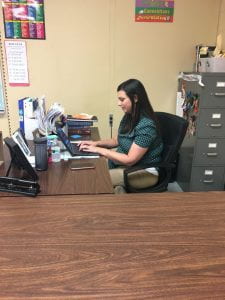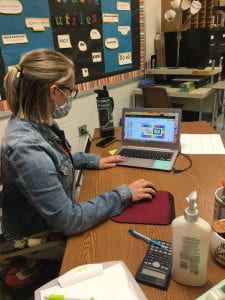Hurdles Teachers Face Dealing with Technology
” There is a lack of time in the classroom to teach students new tech tools. We need professional development…much of our professional development is limited due to our current teaching climate.”

–Kim Mast, High School ELA Teacher, Clinton High School
“I use Google Slideshow, Google notes, Edpuzzle, Flipgrid, Docs, and Forms. I struggle because some of my students prefer to write, so I print things out for them. It’s tough because I feel like I’m giving too many forms; I’m trying to figure out new ways to use technology to connect my students with one another.”
“Teaching Spanish completely digitally is difficult because of the inability to use proper punctuation and accents on the computers.”

–Nicole Binder, High School Spanish Teacher, Clinton High School
“We recently upgraded our library check out system from Follet to Polaris which has been a challenge. Representatives from Polaris don’t come around and update librarians on their system like Follet did, so we are on our own to figure out and maneuver the latest uses of software.”
–Mary Kay Moore, Librarian, Clinton High School

“Working with my Smartboard is difficult to manipulate when teaching math to my Special Ed students. Much of my work becomes individual as I teach them how to use a compass or protractor…my kids struggle with the basics, so teaching them new technology skills on top of that cuts into our time teaching content.”
–Kathy Borngasser, Special Education Teacher, Clinton High School

“My big hurdle is not knowing how to use the different tech tools. I’ve found some things that are easy to use, but it costs money in order to use the cool functions. I don’t know if our district would be willing to pay for these tools.”
–Joe Gordillo, History Teacher, Clinton High School

Action Plan to Overcome Some of Those Hurdles
Speaking with some of my colleagues regarding their technology hurdles made me realize that we all have a lot in common. Most of us want to advance in the use of technology in the classroom, but either feel as if we don’t have the time, the resources, or the money to do so. Most teachers I spoke with understand the advantages of using technology, but feel somewhat burdened under the weight of our current school climate. Taking these things into consideration, I recognize the need for teachers to have the support they need to incorporate technology as a resource that can further education, and not just check the box of “tech used in the classroom.” This sentiment was reiterated in the article, “Ten reasons teachers can struggle using technology in the classroom.” The author states that, “Meaningful technology integration depends on more than device use. There are important steps to make sure integrating technology aligns with how you teach and what you are teaching.” Finding a purpose and a place for technology–justifying its use in the classroom–are important issues when addressing its implementation in curriculum.
One way in which to address some of these concerns might simply deal with attitudes towards the use of technology. The teachers I interviewed reiterated the need for further education in the area of new artifacts or tools available for use in the classroom. According to “Technology in Education: Overcoming Barriers to Success,” these needs are addressed as the author states: “One clear benefit to teachers is a school leader who provides ongoing professional development, encourages experimentation and improvement, and grants freedom to take risks and make mistakes.” A place to start when attempting to delve into the high-tech world might be to gather information from the staff regarding the tools they are currently using and how they are using them in their classrooms. Professional development might simply start within our own school, teaching and sharing with each other ways in which we use technology already. Subsequently, collecting information from staff members as to what areas they may like to explore concerning technology–whether it be in the areas of collaboration, organization, or assessments–could be a springboard into exploring different tools to introduce through professional development offerings.
Another big issue among many staff members deals with time…something we all seem to have too little of. However, as I spoke more deeply with those I interviewed, I understood the lack of time to also mean a lack of time figuring how to use these resources in a manner that doesn’t eat up class time. Theodore J. Kopcha supports a mentoring approach as he states, ” “mentoring and communities of practice to support teachers as they develop skills, pedagogy and beliefs needed to integrate technology in a student-centered manner…“has been found to overcome many of the common barriers to technology integration.” In other words, having a mentor come along side teachers to show them how to use these tools in a practical manner is needed to ease the tensions of teachers, and help them understand and feel comfortable incorporating new technology in the classroom. Much of this process has to do with understanding teachers’ needs and supporting them in their efforts to use technology to enhance the lessons taught to their students.








Recent Comments